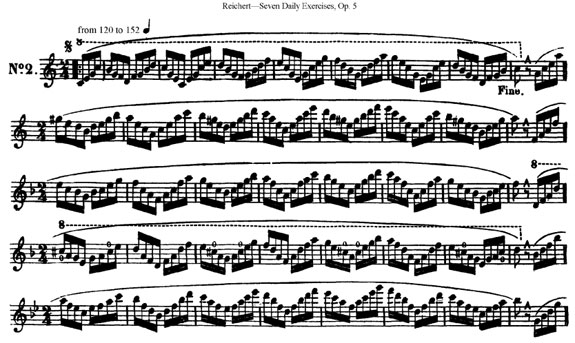Killer Exercises to Get Your Fingers Flying Gracefully Through Every Key
 This guest article is from saxophone and multi-reed player, composer, recording artist, and educator Sam Sadigursky of SamSadigursky.com.
This guest article is from saxophone and multi-reed player, composer, recording artist, and educator Sam Sadigursky of SamSadigursky.com.
For those of you who have read my previous articles, I’m a big proponent of taking the time to get comfortable in any major or minor key. The exercises I’m going to be covering in this article come from the Reichert Daily Exercises for Flute and should be a staple for anybody looking to build technique and command of their keys.
The exercises are quite simple, but have enough twists in them to make them interesting – especially as they hit some of the keys we’re less used to playing in. The exercises all move through majors and their relative minor keys, going couter-clockwise through the Circle of Fifths until every key is addressed.
Click here to download the PDF sheet music for the exercises.
They are all playable on saxophone (and since they are in the public domain, they are free and legal to access online), but I particularly like exercises #2,3, and 4.
Note: Since these are written for the flute, they do go a bit high at certain points. This can be great for those building their altissimo chops, and for those of you who aren’t there yet, you can move them down an octave without a problem.
Exercise #2
This one works through basic major and minor arpeggios, alternating between the root chord (or tonic) and the related dominant, also known as the V chord. This is one of the most fundamental relationships to have a command over, and this exercise will definitely help anybody who hasn’t grasped this relationship quite yet.
We start in C major and play 1-3-5-1, then step down and play 3-1-7-5-7-1-3-5 of the G7 chord, then go DOWN the I chord, and then down the V chord again, but this time from the fifth degree of that chord. This continues, up and down, covering almost two octaves of the horn.
Exercise #3
Here we stay on the tonic chord of our key (mostly), but this time we get acquainted with some chromatic lower neighbor tones, and see some bigger interval jumps as well, which are always great practice.
Beware: Reading the enharmonic spellings of these neighbor tones in some of the thornier key signatures gets very interesting at times.
Exercise #4
This one is significantly simpler than #3, and stays completely on the tonic chord of the respective key that each line is in. The basic pattern is 1-3-6-5-lower neighbor to 5-5-3-1, which we then do in each inversion of the chord, up and down the horn.
Takin’ it to the Shed
Giving these three exercises daily attention can yield amazing results. Don’t forget: It’s not all about speed. Make sure that you’re playing these evenly and with a good sound, always, no matter what the tempo is. And be mindful of what you’re playing and how every note is relating to the one that came before it. This will go a long way in your command of the different keys.
Learn with and Listen to Sam
Sam Sadigursky is currently offering online lessons through Skype and private lessons in NYC. He has given improvisation clinics across the U.S., is a regular guest professor at Hunter College, and currently performs internationally with Darcy James Argue’s Secret Society, Folklore Urbano, and others.
His new book, 12 INTERVALLIC ETUDES for Saxophone, is available here. His albums can be purchased at http://samsadigursky.bandcamp.com.
To find out more, visit SamSadigursky.com.






April 16, 2015 @ 11:28 am
I have always loved borrowing material from the flute literature to develop sax tone and technique. Reichert is great for technique as is Taffanel and Gaubert, as well as Moyse’s Daily Studies. Moyse’s time development material is some of the best I’ve seen. Finally, the Bach flute sonatas are a great workout.
April 16, 2015 @ 11:30 am
Sorry, there’s a typo in the above comment. I meant Moyse’s TONE development material, not TIME.
November 6, 2015 @ 12:42 am
Hello,am just a new person to saxophone,can I have free self tutor for myself.
Thanks.
April 25, 2016 @ 3:42 pm
These look a lot like the daily exercises by H. Klosé. I will stay with the latter, since they are specifically for saxophone, so I don’t have to struggle with notes out of my flagolett range.
April 6, 2018 @ 10:36 pm
Hi i am a one year in sax player and im wondering if anybody can have suggestions for me to improve?
http://www.youtube.com/watch?v=wD8itc7_wVY
May 30, 2018 @ 2:51 pm
Reichert Studies are really good. (Flutist here and I heard the saxophone has the same fingering for almost all notes.) The most challenging for me is the Gb major in study no2. (Shows on the picture but with six flats…) Finally, I got over it making no mistakes (takes time LOL) and now I am just increasing the speed slowly and gradually.
May 30, 2018 @ 3:03 pm
Oh yeah, and one more thing. Reichert studies are written for more intermediate and advanced players. I remember, as an intermediate player I had so much trouble already in study no1 already in Bb major and below. LOL. But slowly and gradually the study are helping acquiring the technique and to be friends with all the keys in major (+) and minor (-) scales and arpeggios and its different variations.